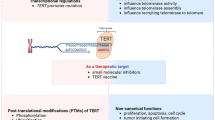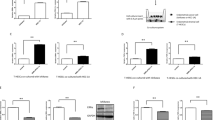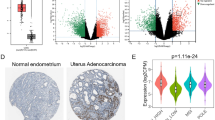Abstract
Tamoxifen is widely applied as an antiestrogenic agent for adjuvant therapy in the treatment of breast cancer, while its estrogen-agonistic activity occasionally causes proliferative disorders or carcinogenesis at other sites, such as the uterus. We reported that estrogen activates telomerase in breast and endometrial cancer cells. The present study examines the effects of tamoxifen on the gene expression of human telomerase reverse transcriptase (hTERT) in breast and endometrial cancer cells. Tamoxifen inhibited the cell growth of MCF-7 cells, as well as hTERT mRNA expression in the presence of estrogen (E2), antagonizing the E2 effects. In contrast, tamoxifen stimulated the growth of Ishikawa cells and activated hTERT mRNA expression in the absence or presence of E2, exhibiting estrogen-agonistic action. Transient expression assays revealed that these actions of tamoxifen are achieved by transcriptional regulation of the hTERT promoter. An estrogen responsive element (ERE) in the hTERT 5′ regulatory region was partly responsible for both the E2-antagonistic and -agonistic actions of tamoxifen. Tamoxifen activated the MAP kinase cascade in Ishikawa cells, but not in MCF-7 cells, and the activation of hTERT mRNA expression was effectively blocked by MEK inhibitor, suggesting that the MAP kinase pathway is involved in the tamoxifen-induced activation of hTERT. These findings indicate that tamoxifen regulates hTERT expression in a cell-type specific manner. Tamoxifen-induced activation of hTERT may be one component of estrogen agonistic function of tamoxifen that is involved in endometrial carcinogenesis induced by this agent.
This is a preview of subscription content, access via your institution
Access options
Subscribe to this journal
Receive 50 print issues and online access
$259.00 per year
only $5.18 per issue
Buy this article
- Purchase on Springer Link
- Instant access to full article PDF
Prices may be subject to local taxes which are calculated during checkout





Similar content being viewed by others
References
Bergman L, Beelen ML, Gallee MP, Hollema H, Benraadt J, van Leeuwen FE . 2000 Lancet 356: 881–887
Berry M, Metzger D, Chambon P . 1990 EMBO J. 9: 2811–2818
Bodnar AG, Ouellette M, Frolkis M, Holt SE, Chiu CP, Morin GB, Harley CB, Shay JW, Lichtsteiner S, Wright WE . 1998 Science 279: 349–352
Colacurci N, De Seta L, De Franciscis P, Mele D, Fortunato N, Cassese S . 2000 Panminerva. Med. 42: 45–47
Collins P, Webb C . 1999 Nat. Med. 5: 1130–1131
Counter CM, Avilion AA, LeFeuvre CE, Stewart NG, Greider CW, Harley CB, Bacchetti S . 1992 EMBO J. 11: 1921–1929
Endoh H, Sasaki H, Maruyama K, Takeyama K, Waga I, Shimizu T, Kato S, Kawashima H . 1997 Biochem. Biophys. Res. Commun. 235: 99–102
Fan JD, Wagner BL, McDonnell DP . 1996 Mol. Endocrinol. 10: 1605–1616
Goldstein SR . 2000 Eur. J. Cancer 36: Suppl 4 54–56
Hahn WC, Stewart SA, Brooks MW, York SG, Eaton E, Kurachi A, Beijersbergen RL, Knoll JH, Meyerson M, Weinberg RA . 1999 Nat. Med. 5: 1164–1170
Harley CB, Kim NW, Prowse KR, Weinrich SL, Hirsch KS, West MD, Bacchetti S, Hirte HW, Counter CM, Greider CW . 1994 Cold Spring Harb. Symp. Quant. Biol. 59: 307–315
Ito H, Kyo S, Kanaya T, Takakura M, Inoue M, Namiki M . 1998 Clin. Cancer Res. 4: 1603–1608
Jamil A, Croxtall JD, White JOJ . 1991 Mol. Endocrinol. 6: 215–221
Kato S, Endoh H, Masuhiro Y, Kitamoto T, Uchiyama S, Sasaki H, Masushige S, Gotoh Y, Nishida E, Kawashima H . 1995 Science 270: 1491–1494
Kim NW, Piatyszek MA, Prowse KR, Harley CB, West MD, Ho PL, Coviello GM, Wright WE, Weinrich SL, Shay JW . 1994 Science 266: 2011–2015
Kyo S, Kanaya T, Takakura M, Tanaka M, Inoue M . 1999a Int. J. Cancer 80: 60–63
Kyo S, Takakura M, Kanaya T, Wang Z, Fujimoto K, Nishio Y, Orimo A, Inoue M . 1999b Cancer Res. 59: 5917–5921
Lasset C, Bonadona V, Mignotte H, Bremond A . 2001 Lancet 357: 66–67
Mandlekar S, Yu R, Tan TH, Kong AN . 2000 Cancer Res. 60: 5995–6000
Migliaccio A, Di Domenico M, Castoria G, de Falco A, Bontempo P, Nola E, Auricchio F . 1996 EMBO J. 15: 1292–1300
Mimnaugh EG, Chavany C, Neckers L . 1996 J. Biol. Chem. 271: 22796–22801
Nakayama J, Tahara H, Tahara E, Saito M, Ito K, Nakamura H, Nakanishi T, Ide T, Ishikawa F . 1998 Nat. Genet. 18: 65–68
Norris JD, Paige LA, Christensen DJ, Chang CY, Huacani MR, Fan D, Hamilton PT, Fowlkes DM, McDonnell DP . 1999 Science 285: 744–746
Rosenbaum Smith SM, Osborne MP . 2000 Am. J. Surg. 180: 249–251
Schwartzl B, Krey L, Demopoulos R, Goldstein SR, Nachtigall LE, Mittal K . 1997 Am. J. Obstet. Gynecol. 176: 129–137
Shay JW, Bacchetti S . 1997 Eur. J. Cancer 33: 787–791
Shiau AK, Barstad D, Loria PM, Cheng L, Kushner PJ, Agard DA, Greene GL . 1998 Cell 95: 927–937
Singer CA, Figueroa-Masot XA, Batchelor RH, Dorsa DM . 1999 J. Neurosci. 19: 2455–2463
Soda H, Raymond E, Sharma S, Lawrence R, Davidson K, Oka M, Kohno S, Izbicka E, Von Hoff DD . 2000 Prostate 43: 161–168
Sundaresan S, Colin IM, Pestell RG, Jameson JL . 1996 Endocrinology 137: 304–311
Tora L, White J, Brou C, Tasset D, Webster N, Scheer E, Chambon P . 1989 Cell 59: 477–487
Tzukerman MT, Esty A, Santiso-Mere D, Danielan P, Parker MG, Stein RB, Pike JW, McDonnell DP . 1994 Mol. Endocrinol. 8: 21–30
Wang Z, Kyo S, Takakura M, Tanaka M, Yatabe N, Maida Y, Fujiwara M, Hayakawa J, Ohmichi M, Koike K, Inoue M . 2000 Cancer Res. 60: 5376–5381
Webb P, Lopez GN, Uht RM, Kushner P . 1995 J. Mol. Endocrinol. 9: 443–456
Weinstein SL, Gold MR, DeFranco AL . 1991 Proc. Natl. Acad. Sci. USA 88: 4148–4152
Zhang CC, Shapiro DJ . 2000 J. Biol. Chem. 275: 479–486
Acknowledgements
We are grateful to Dr Masato Nishida (Department of Obstetrics and Gynecology, Tsukuba University, Japan) for providing Ishikawa cells. This study was supported in part by a Grant-in-Aid for the Second Term Comprehensive 10-year Strategy for Cancer Control from the Ministry of Health and Welfare as well as the Hokkoku Cancer Foundation, Japan.
Author information
Authors and Affiliations
Corresponding author
Rights and permissions
About this article
Cite this article
Wang, Z., Kyo, S., Maida, Y. et al. Tamoxifen regulates human telomerase reverse transcriptase (hTERT) gene expression differently in breast and endometrial cancer cells. Oncogene 21, 3517–3524 (2002). https://doi.org/10.1038/sj.onc.1205463
Received:
Revised:
Accepted:
Published:
Issue Date:
DOI: https://doi.org/10.1038/sj.onc.1205463
Keywords
This article is cited by
-
The antiretroviral agent saquinavir enhances hTERT expression and telomerase activity in human T leukaemia cells in vitro
Journal of Experimental & Clinical Cancer Research (2013)
-
Telomerase expression and telomere length in breast cancer and their associations with adjuvant treatment and disease outcome
Breast Cancer Research (2011)
-
Molecular mechanisms of oestrogen and SERMs in endometrial carcinogenesis
Nature Reviews Cancer (2006)
-
Hypomethylation-linked activation of PAX2 mediates tamoxifen-stimulated endometrial carcinogenesis
Nature (2005)
-
The tamoxifen-induced suppression of telomerase activity in the human hepatoblastoma cell line HepG2: a result of post-translational regulation
Journal of Cancer Research and Clinical Oncology (2005)



